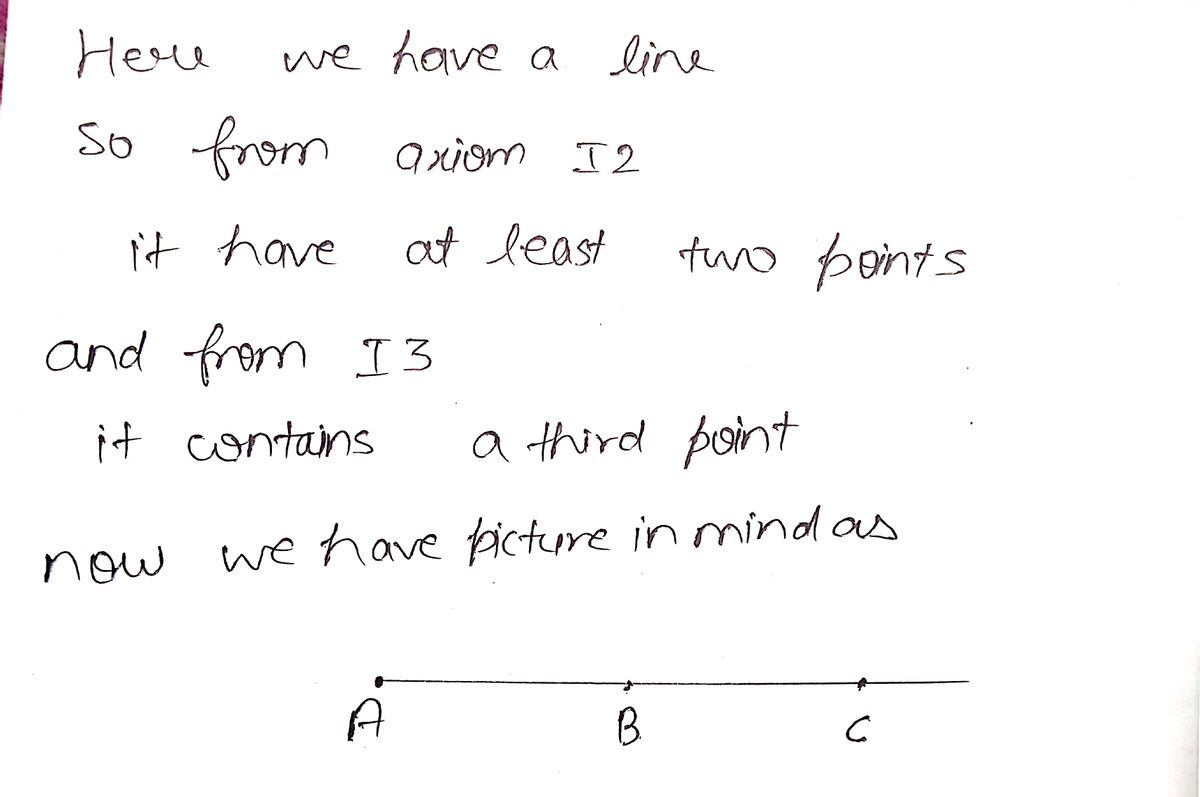Elementary Geometry For College Students, 7e
7th Edition
ISBN:9781337614085
Author:Alexander, Daniel C.; Koeberlein, Geralyn M.
Publisher:Alexander, Daniel C.; Koeberlein, Geralyn M.
ChapterP: Preliminary Concepts
SectionP.CT: Test
Problem 1CT
Related questions
Question
Using (11)-(13) and (B1)-(B4) and their consequences, show that every line has infinitely many distinct points.

Transcribed Image Text:except for the theory of area, whose proof is postponed until Chapter 5.
lid, Books I-IV,
6 Axioms of Incidence
The axioms of incidence deal with points and lines and their intersections. The
points and lines are undefined objects. We simply postulate a set, whose ele-
ments are called points, together with certain subsets, which we call lines. We do
not say what the points are, nor which subsets form lines, but we do require that
these undefined notions obey certain axioms:
II. For any two distinct points A, B, there exists a unique line I containing A, B.
12. Every line contains at least two points.
13. There exist three noncollinear points (that is, three points not all contained
in a single line).
Definition
A set whose elements are called points, together with a set of subsets called
lines, satisfying the axioms (11), (12), (13), will be called an incidence geometry.
If a point P belongs to a line 1, we will say that P lies on 1, or that I passes
through P.
From this modest beginning we cannot expect to get very interesting results,
but just to illustrate the process, let us see how one can prove theorems based
on these axioms.
Proposition 6.1
Two distinct lines can have at most one point in common.
te & B with

Transcribed Image Text:In this section we present axioms to make precise the notions of betweenness
(when one point is in between two others), on which is based the notion of
sidedness (when a point is on one side of a line or the other), the concepts of
inside and outside, and also the concepts of order, when one segment or angle is
bigger than another. We have seen the importance of these concepts in reading
Euclid's geometry, and we have also seen the dangers of using these concepts
intuitively, without making their meaning precise. So these axioms form an
important part of our new foundations for geometry. At the same time, these
axioms and their consequences may seem difficult to understand for many
readers, not because the mathematical concepts are technically difficult, but
because the notions of order and separation are so deeply ingrained in our daily
experience of life that it is difficult to let go of our intuitions and replace them
with axioms. It is an exercise in forgetting what we already know from our inner
nature, and then reconstituting it with an open mind as an external logical
structure.
Throughout this section we presuppose axioms (11)-(13) of an incidence
geometry. The geometrical notions of betweenness, separation, sidedness, and
order will all be based on a single undefined relation, subject to four axioms. We
postulate a relation between sets of three points A, B, C, called "B is between A
and C." This relation is subject to the following axioms.
B1. If B is between A and C, (written A * B * C), then A, B, C are three distinct
points on a line, and also C * B * A.
B2. For any two distinct points A, B, there exists a point C such that A* B * C.
B3. Given three distinct points on a line, one and only one of them is between
the other two.
2. Hilbert's Axioms
B4. (Pasch). Let A, B, C be three non-
collinear points, and let 1 be a line
not containing any of A, B, C. If 1
contains a point D lying between
A and B, then it must also contain
either a point lying between A and
C or a point lying between B and C,
but not both.
l
B
D
C
Expert Solution
Step 1

Trending now
This is a popular solution!
Step by step
Solved in 2 steps with 2 images

Recommended textbooks for you

Elementary Geometry For College Students, 7e
Geometry
ISBN:
9781337614085
Author:
Alexander, Daniel C.; Koeberlein, Geralyn M.
Publisher:
Cengage,

Elementary Geometry for College Students
Geometry
ISBN:
9781285195698
Author:
Daniel C. Alexander, Geralyn M. Koeberlein
Publisher:
Cengage Learning

Elementary Geometry For College Students, 7e
Geometry
ISBN:
9781337614085
Author:
Alexander, Daniel C.; Koeberlein, Geralyn M.
Publisher:
Cengage,

Elementary Geometry for College Students
Geometry
ISBN:
9781285195698
Author:
Daniel C. Alexander, Geralyn M. Koeberlein
Publisher:
Cengage Learning